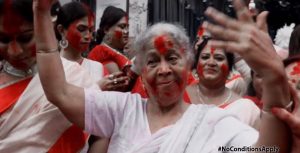

The Calcutta Times’ #NoConditionsApply campaign aims to change the division that religious and societal tradition creates. Made by FCB Ulka, the campaign is based on the 400-year-old tradition of Sindoor Khela on the last day of the auspicious Durga Puja, a festival that Bengalis all around the world celebrate every year. The sindoor, as in vermillion, is what married Hindu women put in the parting of their hair, to indicate their marital status. Sindoor Khela is a riot of colours wherein married Bengali women endorse Durga’s, as well as their own marital prosperity, by applying vermillion on the idol’s face and then to each other. The widows, the transgender, the sex workers are not allowed to be a part of such a celebration. There’s an unwritten divide between the married women and the rest of the women in the community.
During this year’s Durga Puja in Kolkata, Calcutta Times took the initiative to invite the transgender community (from Kolkata Rista, an NGO for transgenders), sex workers (from Sonagachi, one of the biggest red light areas in Kolkata) and widows (from Ramkrishna Ashram, an ashram for widows) to take part in the Sindoor Khela celebrations along with married women. According to age old traditions, widows aren’t supposed to play with sindoor, because it is the very essence of having a husband. Them, being a part of the celebrations, is supposed to bring bad luck and considered a sin. On the day of Sindoor Khela, we see all these women dressed up in the traditional white saree with red border, joyously taking part in the festivities. There are smiling faces, a heart-wrenching background score and the constant echo of the usual ‘Bolo Durga Mai ki Joy’, complete with the sound of dhaak. It ends with the super – ‘Coming together without division is true celebration’. Sweet, right? Yet something seems incomplete.
The #NoConditionsApply campaign is represented by two red dots, emphasising that there’s no barrier between the married women and the ‘other’ women, the campaign goes on to suggest. It’s a symbol of equality. Calcutta Times has tried to show sisterhood through this campaign, which is laudable, but my question is, what is it doing for the brand in question? Even if you’re trying to highlight an issue that plagues the society, it should have some sort of semblance or relevance with the brand – otherwise you just come out looking superficial. I’ve no problem with the idea behind the campaign; in fact it is a brilliant thought and a great way of attempting to shatter age-old traditions to prove the real meaning of celebrations. It’s a lovely, well-made film but I feel it falls short because of how unbelievable it looks. I mean, I’d be happy if this comes true but somewhere you know it’s not going to happen, so immediately the campaign loses steam.
Using a social cause just to further your brand’s agenda seems to be like a trend these days. A few months ago, Vicks had come up with a TVC about a transgender mother and her adopted daughter that had broken the internet. What did Vicks do for the transgender community? What did the idea of showing a transgender mother, as opposed to, say, a heterosexual mother, do for Vicks as a brand? Zilch. The Calcutta Times campaign was a like a déjà vu moment for me. What does the #NoConditionsApply campaign do for Calcutta Times as a brand? If you show the same campaign and say that it’s a campaign made by say, a Dettol or The Hindu or Lux or even, Minu Sarees – how is it different? My point: It can be a campaign or an advertisement for anything, not just Calcutta Times. In a bid to champion for social causes, are we losing the real point of an advertisement completely? Think about it.



